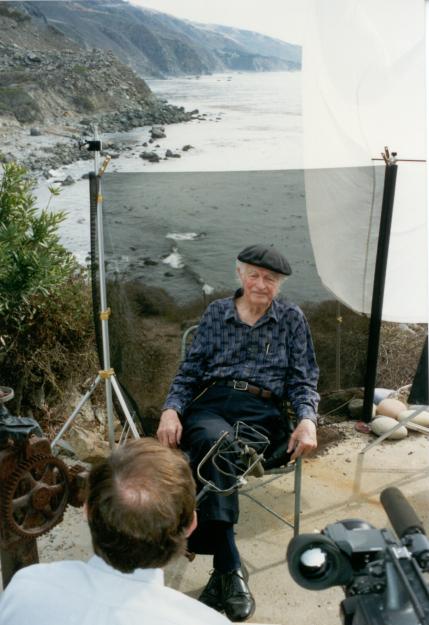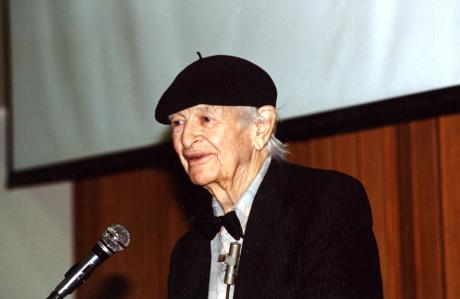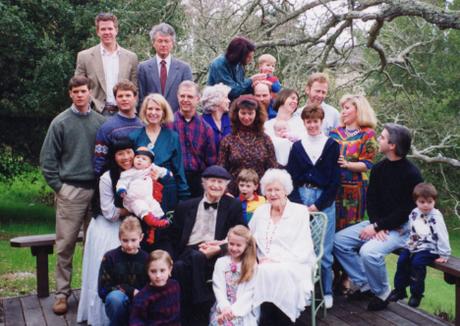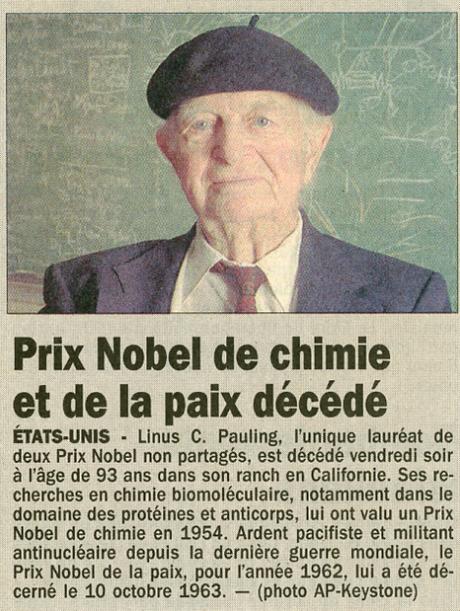
Linus Pauling giving an interview at Deer Flat Ranch, September 1993.
[Part 3 of 4]
After a sigmoidoscopy in 1993 revealed that Linus Pauling’s rectal tumor was still growing, the reality set in that he was not likely to survive his cancer. It was at this point that Pauling began to seriously consider which of his possessions should be turned over to family and which should be transferred to his archival collection at Oregon State University.
The same year, it was decided that it would be a good idea to arrange a special symposium, sponsored by Caltech and the Linus Pauling Institute of Science and Medicine, on or near his 93rd birthday. Speakers would consist of former graduate students and postdocs. Pauling had once imagined that an event of this sort would be appropriate for his 100th year, a birthday that he had fully intended to achieve.
Throughout 1993, Pauling strived to be as active as possible, giving interviews in person or over the telephone, and entertaining many visitors at Deer Flat Ranch. At the end of May, Pauling and a collection of friends, family, and co-workers also gathered to celebrate the Linus Pauling Institute of Science and Medicine’s 20th anniversary.
However, as time move forward and his illness worsened, Pauling attended to his scientific writing and correspondence at a decreasing rate. On two occasions, he returned to Palo Alto to attend scientific meetings, giving a short talk at one, and the last scientific paper that he authored himself was written in November-December of 1993. Much of his time was taken up with scheduled visits to his doctors in San Luis Obispo and Cambria, or simply resting at Deer Flat Ranch, his sanctuary on the Pacific Ocean.

Pauling delivering his last lecture at the International Symposium on Biological NMR, Stanford University, March 25, 1994.
In January 1994, Pauling’s physicians decided that steps needed to be taken to shrink his tumor, and Pauling relented to a course of chemotherapy, during which he attributed his lack of negative side effects to his taking routine megadoses of vitamin C. When Pauling learned that the cancer had spread to his liver, however, his hope to live to be one-hundred years old were lost. He stopped taking vitamin C completely, and gave up writing in his research notebook – a brief note about his work on nuclear structure appears in January and the pages after it are blank.
During the last months of his life, Pauling met with friends and family, while also attending to some less pleasant business. LPISM administrator Steve Lawson and Linus Pauling, Jr. journeyed to Deer Flat Ranch during this time to mediate ongoing litigation between the Institute and Matthias Rath, who had initiated a lawsuit against his former employer. Even at the deposition, which given from his bed, Pauling welcomed Rath warmly.
Pauling’s final public appearance came on June 19, 1994, at the conference that he had requested be organized a year earlier, and which his son Crellin had arranged. This event, which was ultimately hosted by The Pacific Division of the American Association for the Advancement of Science, was titled “A Tribute for Linus Pauling” and was held at San Francisco State University. Pauling’s ranch hand Steve Rawlings attended as Pauling’s nurse, bringing him into the assembly in a wheelchair. Upon entering however, Pauling stood and insisted on walking into the room, receiving applause from the gathering as he made his way to his chair. An array of speakers including Harden McConnell, Alexander Rich, Frank Catchpool, Richard Kunin, and Crellin Pauling delivered moving talks detailing Pauling’s major contributions to science, human health, and world peace.

A final family photo session, on Pauling’s 93rd birthday. Seated to Pauling’s left is his sister, Pauline, who lived to the age of 101.
Pauling’s daughter Linda was at Deer Flat Ranch with her husband and children on August 18, 1994, when Pauling suffered a stroke that left him comatose. Pauling’s sons Crellin and Linus Jr. arrived the next day and were both at the ranch with him on the evening that he died. His passing came at the end of a beautiful summer day, as the sun was just beginning to set over the Pacific. At the end of his life, Pauling wore on his wrist an opal bracelet that he had once given to his late wife, Ava Helen, as a gift.
In Palo Alto, Steve Lawson had just sat down for dinner when he received a call from Linus Pauling Jr., informing him of the sad news. Immediately, Lawson got in his car and went back to the Institute, faxing pre-written obituaries to the media. Copies went to CBS, the New York Times, NBC, CNN, the San Francisco Chronicle, the San Jose Mercury-News, and half a dozen more outlets. But by the time that Lawson had faxed the third news organization, the phone started ringing. He later recalled
In those days, we had an old fashioned phone system where you could see a number of little pegs that would light up for an incoming line, and I think there were as many as six incoming lines. Before long every light was lit and blinking: it was the New York Times, it was CBS, it was everybody under the sun that wanted statements.
Pauling’s passing was reported the next day through packages of stories in the New York Times and the Los Angeles Times that were immediately picked up by news services and syndicated around the globe. The Pasadena Star-News ran its own article a few days later, as did the Medical Tribune and the scientific journal Nature. Personal letters flooded in to the Pauling children and the Institute from every corner of the globe: France, the United Kingdom, Russia, Japan, Italy, Australia, South America, the Philippines, and all across the United States. Universities and organizations worldwide, including Caltech and the American Association for the Advancement of Science, all sent heartfelt letters conveying their sadness at the loss of a great man.

In the months and years that followed, Pauling’s life was honored around the world in a wide variety of ways. The Alpha Chi Sigma chemistry fraternity, which is based in Indianapolis, dedicated the Library Room of its house to Pauling. A fossil leaf from an extinct species of citrus tree was also named after him: Linusia paulinga.
Later on in 1994, shortly after Pauling’s death, Steve Lawson started receiving unmarked packages in the mail, containing nearly exact replicas of Pauling’s Nobel Prizes. A week or two after they had arrived, Pauling’s son Peter, then living in Wales, called and cryptically asked if Lawson had received anything “unusual” in the mail. As it turned out, Peter had gone to the Nobel Academies and had duplicate medals struck in an alloy for family members and for the Institute to hold as keepsakes.
Later still, with the help of Pauling’s daughter Linda and officials at Oregon State University, Lawson and others planned a Linus Pauling Exhibition, which was sponsored by the Japan-based peace organization, Soka Gakkai International. Intended as a mechanism to educate the public about Pauling’s work and to introduce school children to Pauling as a role model, the exhibit focused on all facets of Pauling’s career as a humanitarian, as an activist, as a scientist, and as a medical researcher. Over the course of several years, millions of people visited the exhibit in Europe, Japan, and many locations in the United States, including Washington D.C., San Francisco, and Boston. The exhibit was created by a team of designers who, when it had finished touring, donated all of its elements and infrastructure to Oregon State University.
